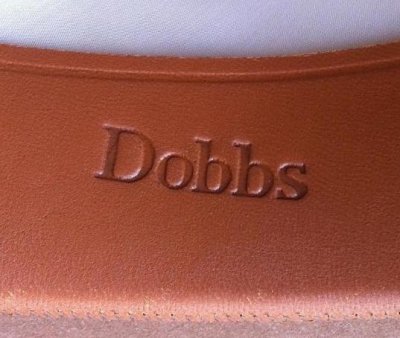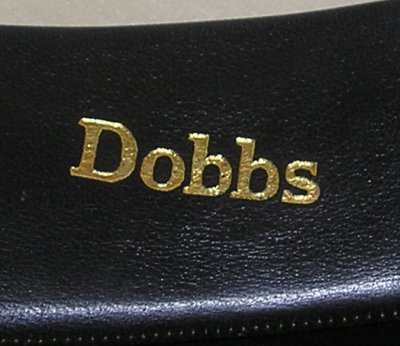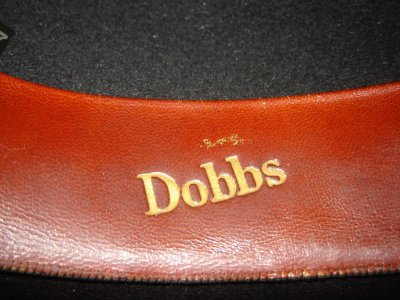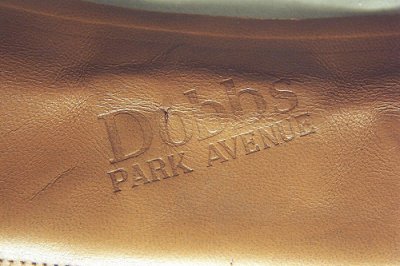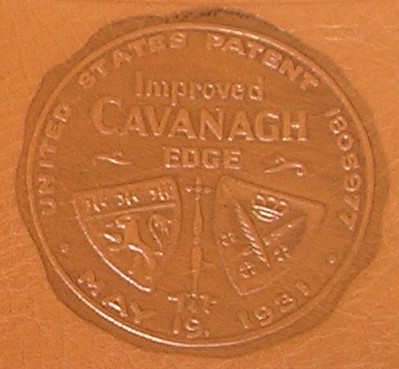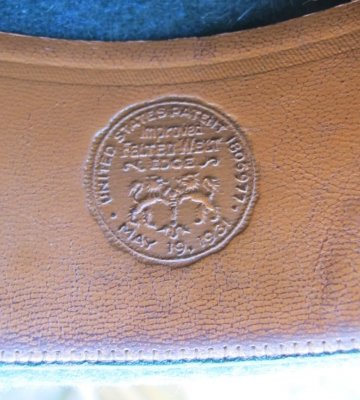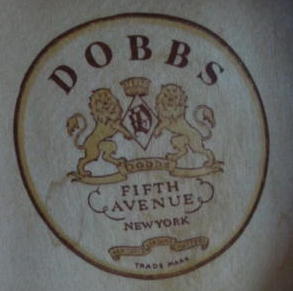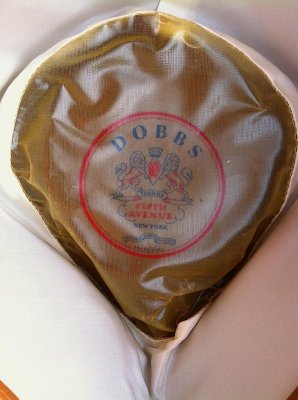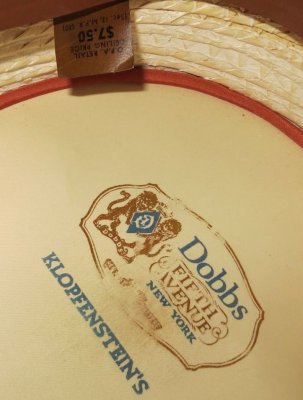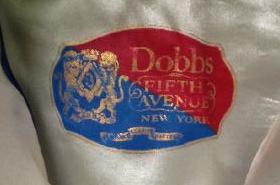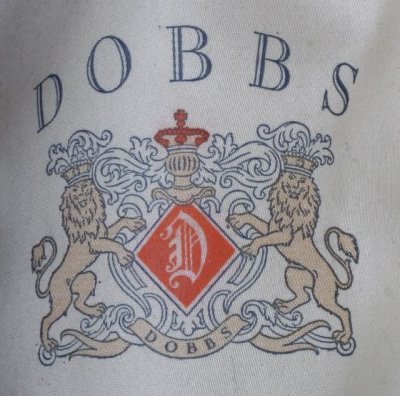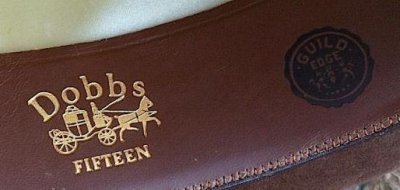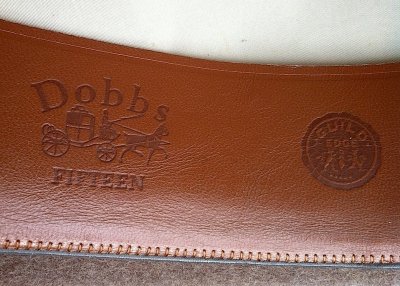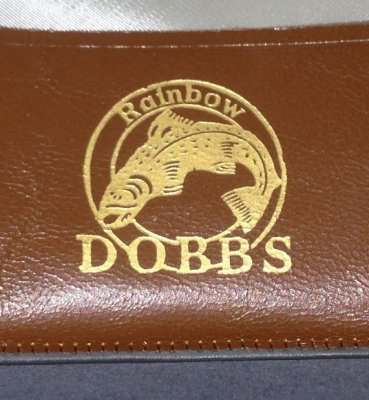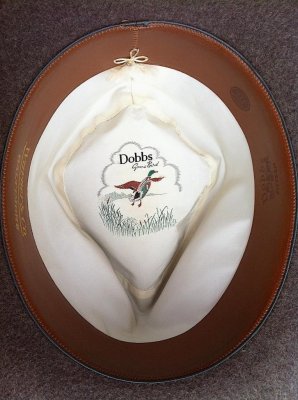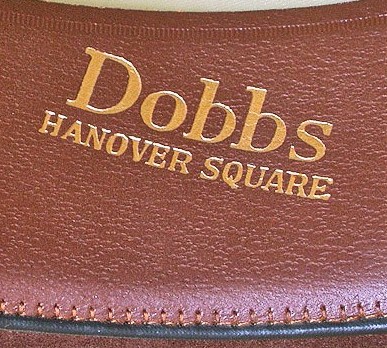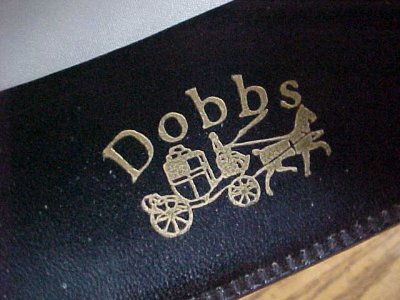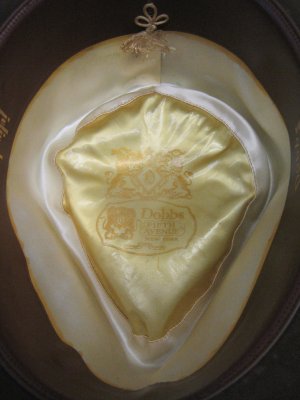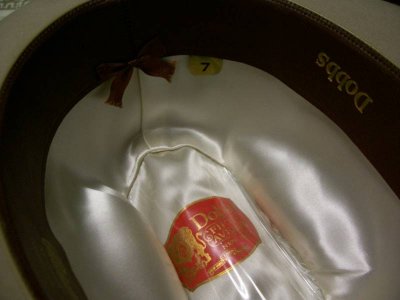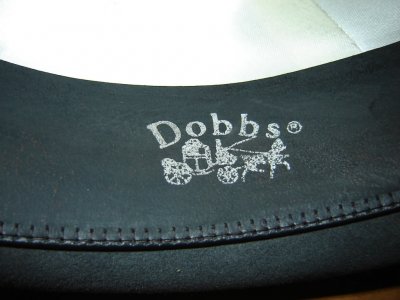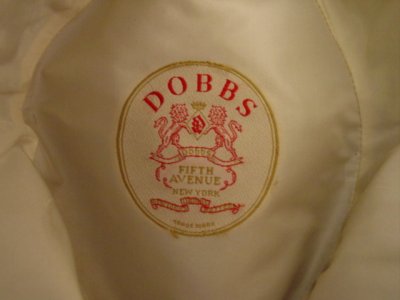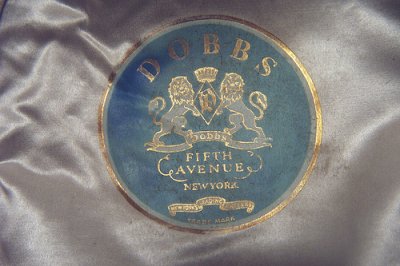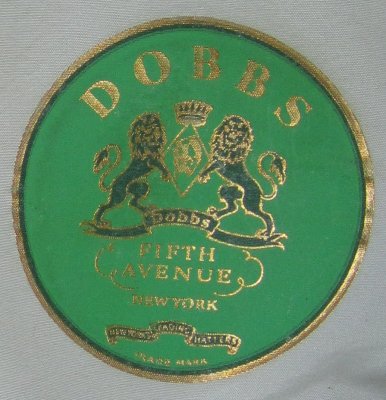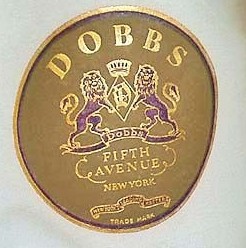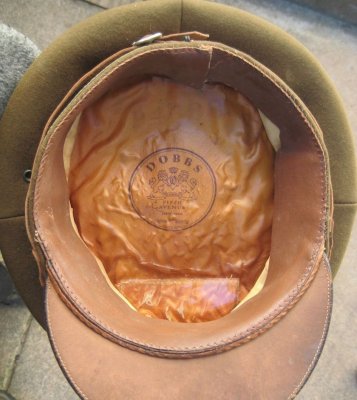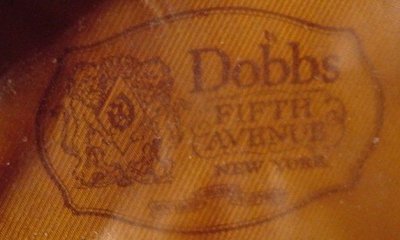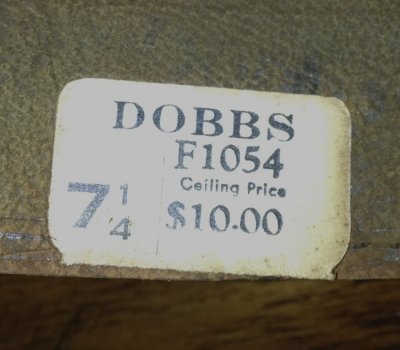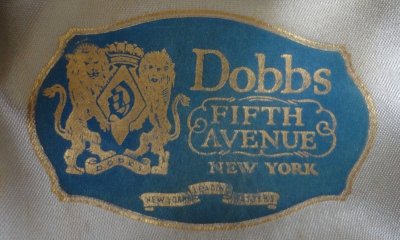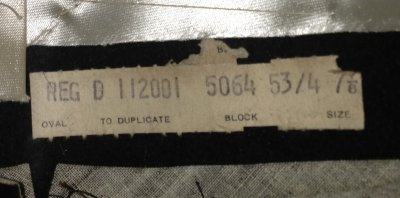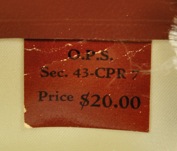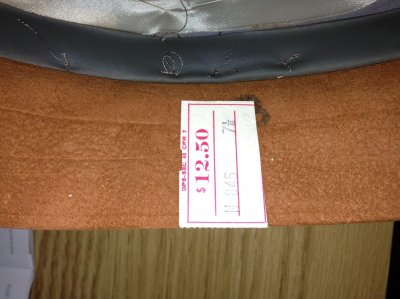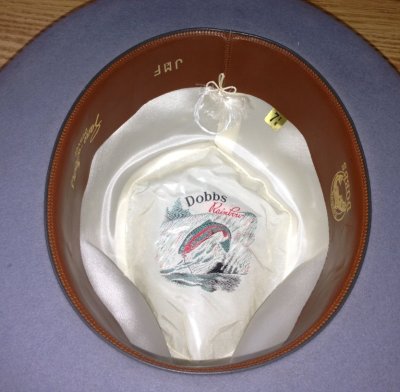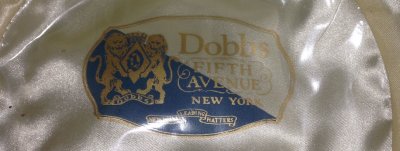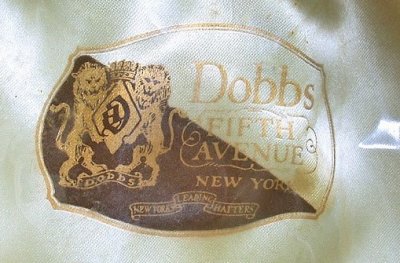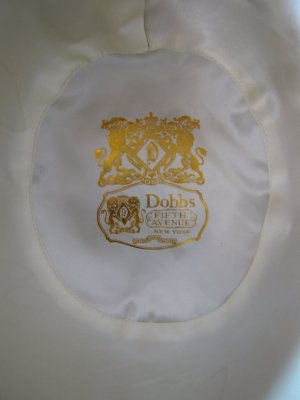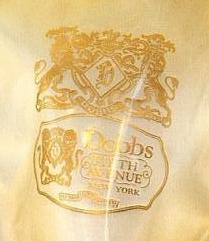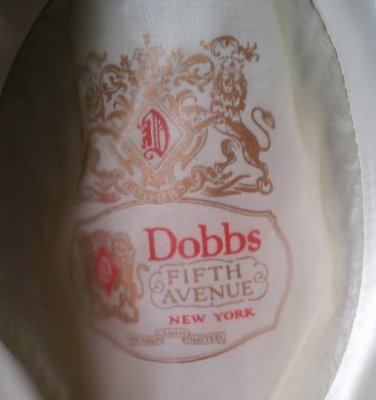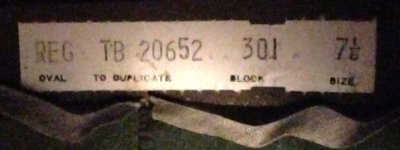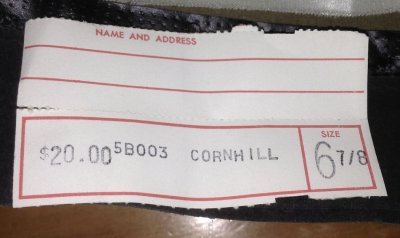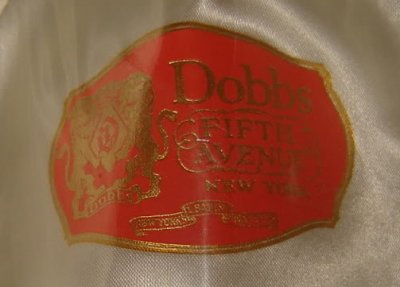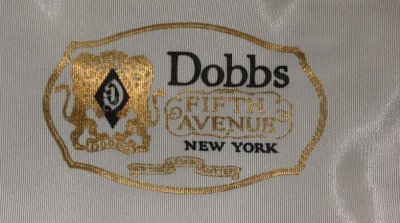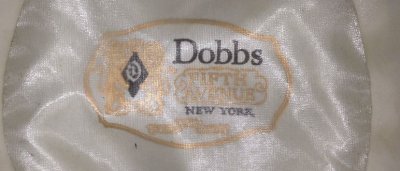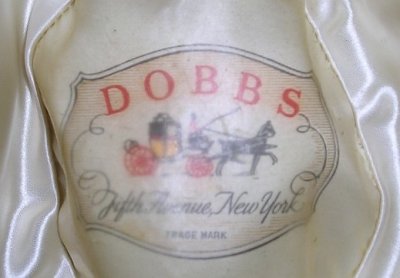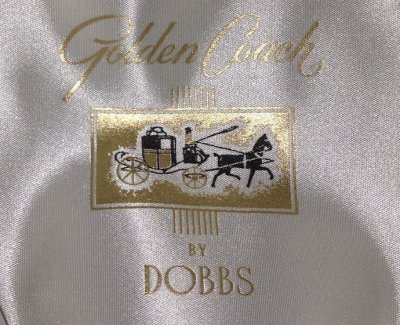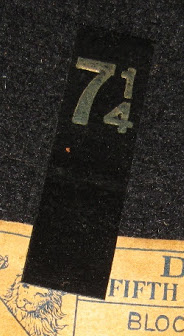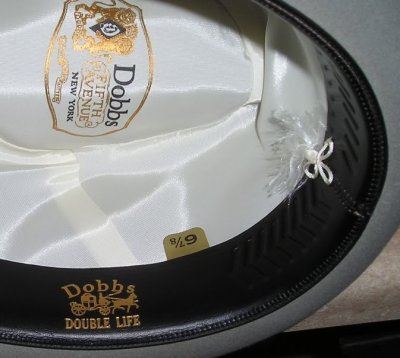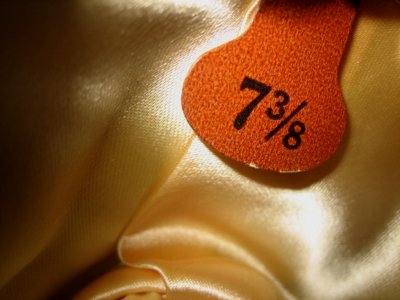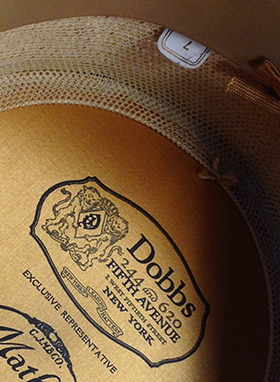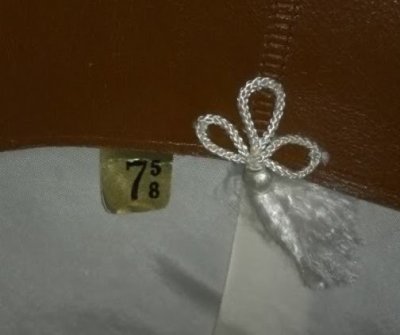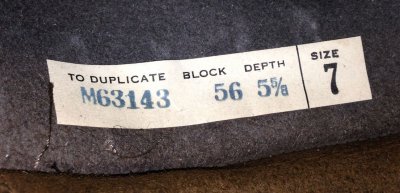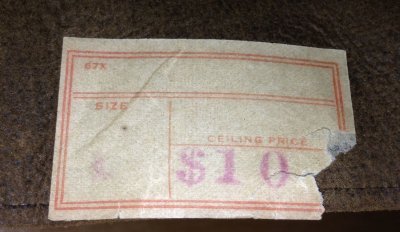Brad Bowers
I'll Lock Up
- Messages
- 4,187
The Fedora Lounge Guide to Dating Dobbs Hats
Part I: 1908 - 1940
View attachment 10285
NOTE: This guide will utilize liner tips and factory labels, and to a certain extent, sweatband stamps, to date Dobbs hats to within a decade, or within a few years, as the case may be. It is by no means comprehensive. There are multiple variation of all liners, labels, and stamps used throughout the years, and this guide only touches on a few that seem to be common.
The easiest method to date early Dobbs hats is through the Dobbs crest on the liner tips. Dobbs included the address in the crest, and because we know the dates and locations of their shops, we can be fairly certain on dating these hats to within a few years of accuracy. Dobbs factory reorder labels are also useful, but more so once we hit the 1940s, when they became standardized across all Hat Corporation of America brands. Prior to 1940, factory labels are included below immediately following the liner in their associated hat. You will see that the labels are inconsistent in their usage prior to 1940, so by themselves they don't offer enough clues. The same holds true for retail size tags. There were several styles, and their usage covers decades in some instances, and not consistently. Size tags will be addressed in an addendum below.
1908 – 1914
The original Dobbs & Co. retail store opened for business on September 15, 1908 at 242 Fifth Avenue in New York City. They remained at this address until the end of 1914. Dobbs Hats from this period feature the address, at least on the silk hat examples I have seen. Note that below the address the banner reads “The Knapp-Felt Shop,” as the primary hats Dobbs & Co. sold during this period were Crofut & Knapp, Knapp-Felt, and Knapp-Felt De Luxe. I haven’t seen any Dobbs’ Derby or soft hat examples from this period, but they should be similar; however, it’s always possible they omitted the address from them. The silk hats I have seen did not have factory labels, so I have yet to ascertain what these early labels looked like.
View attachment 10286
1915 – 1917
At the beginning of 1915, Dobbs & Co. moved next door to a larger shop at 244 Fifth Avenue. While I don’t have any examples, I suspect that liner tips were updated for the new address.
View attachment 10278
1908 - 1909 Union Label
Crofut & Knapp allowed the United Hatters of North America to place their label in C&K hats from 1896 until 1909. After a strike paralyzed the company, C&K discontinued the use of the Union label in January 1909 and forced the union completely out of the factory on February 8, 1909. For a very brief few months, then, from September 1908 through January 1909, Dobbs hats probably featured a union label. This example is from a C&K hat between prior to 1909. The union was kept out of the factory until 1946, but union labels would not show up again on Hat Corporation of America hats until the 1960s.
View attachment 10279
1917 – 1919
On May 1, 1917, Dobbs & Co. opened a new flagship store at 620 Fifth Avenue. Liner tips were most likely updated with both addresses at that time. This is possibly an example of a 1917-1919 hat because there is no 2 West Fiftieth Street on the address, but it could also be post-1922 because it says “New York’s Leading Hatters” on the banner (See next date period). It is an exception to one of these periods.
View attachment 10287
1919 – 1922
In June 1919, Dobbs & Co. leased additional space at 618 Fifth Avenue, as well as extended space around the corner at 2 West Fiftieth Street. The latter address was added to liner tips, while the former was not.
View attachment 10288 View attachment 10289
The above two photos are by and courtesy of Joshua Brutzkus.
View attachment 10290 View attachment 10291
1922 – January or February of 1927
In a 1934 trademark filing, Dobbs removed “The Knapp Felt Shops” from the banner and replaced it with “New York’s Leading Hatters,” claiming it had been in use on their hat liners since 1922. Additionally, by 1924 they had added 4 and 6 West Fiftieth Street to the 620 Fifth Avenue store, giving them an impressive retail outlet. This perhaps explains the rearrangement in the order of the addresses, as 620 had far surpassed 244 Fifth Avenue in importance. This example also feature a different factory label.
View attachment 10292 View attachment 10293
The above two photos by and courtesy of Robert Kent.
Alternate 1922 – 1930s? Liner
Here is a liner style that was first used in 1922, and may have been used into the 1930s. It's not as common. Note that in the trademark filing and the first physical example, on each side of scrolling banner the addresses 620 (on the left) and 244 (on the right) were used. This means it could be from 1922 until the beginning of 1927. On what appear to be later versions, the addresses have been omitted.
View attachment 10294
View attachment 10295 View attachment 10296
January or February 1927 – 1929, or perhaps as late as 1931
Sometime in early 1927, by mid-March at the very latest, the old shop at 244 Fifth Avenue had closed and a new store was opened at 324 Fifth Avenue. Once again, the address would be updated, but this time was the last time Dobbs liners would sport the addresses. Why 324 was placed before 620 is a matter open for debate.
Dobbs & Co. opened their grandest store yet at 1 West Fifty-seventh Street and Fifth Avenue on October 16, 1928. 324 Fifth Avenue remained open, as well as a location at Fifth Avenue and West Fiftieth Street, though which address is unknown at this time. Dobbs & Co. most assuredly did not need the square footage that 620 had offered to that point, so it’s probable that they scaled back. References beyond 1929 only mention Fifth and West Fiftieth.
1 West Fifty-Seventh was never given the liner tip treatment. Perhaps 1928 is when the address was removed from hat liners, or perhaps 324 and 620 continued for a little while longer in the tips. Construction on Rockefeller Center started around 1931 and the old buildings were torn down. 1 West Fifty-Seventh Street closed due to bankruptcy in mid-1931, and 324 Fifth Avenue was gone by 1933.
View attachment 10297 View attachment 10298
1930s
This decade sees some new crests featured in liner tips.
The following example from 1936 is probably representative of a common Dobbs crest in the early part of the decade.
View attachment 10299 View attachment 10300
The above two photo by and courtesy of Robert Kent.
Dobbs also used a 1930s variant label that is lineless.
View attachment 10301
This liner example is embroidered.
View attachment 10302 View attachment 10303
This variation is from 1938. It would show up again in the early-1950s, though with a plastic liner-tip protector. It also has a variant of the lineless label.
View attachment 10304 View attachment 10305
The above two photos by and courtesy of Robert Kent.
1933 – 1935
One easy way to tell a hat from the summer of 1933 until the end of May 1935 is by addition of the National Recovery Administration (NRA) label, featuring the famous blue eagle. This New Deal program, as it relates to our hatting history, involved the government convincing the industries, corporations, and businesses of America to agree to minimum wages for workers, and for our hats, price floors on items manufactured and sold. Long story short, the law that created the NRA was found unconstitutional by the U.S. Supreme Court on May 27, 1935, and price floors and labels were no longer applied to goods. Here is an example of an NRA label in a Cavanagh soft felt hat, but all Hat Corporation of America hats subject to the price control should feature the same or similar label. If you have one of these labels in your hat, then congratulations, you've narrowed the manufacturing window to as close as you'll be able to get it without something like a verified sales receipt!
View attachment 10306
1934 – circa-1940 Roundel
On April 12, 1934, Dobbs began using a Roundel design in some liner tips. This is from the trademark filing.
View attachment 10307
View attachment 10308 View attachment 10280
View attachment 10309 View attachment 10281
Circa-1940
Sometime around 1940 Hat Corporation of America began their push for standardization of all factory labeling. A transitional type of label is shown following the Roundel below. This may have lasted into at least 1942, as an example exists of one that mentions a price ceiling on a price tag.
View attachment 10310
View attachment 10311
Another example of a circa-1940 transitional label.
View attachment 10312
Part I: 1908 - 1940
View attachment 10285
NOTE: This guide will utilize liner tips and factory labels, and to a certain extent, sweatband stamps, to date Dobbs hats to within a decade, or within a few years, as the case may be. It is by no means comprehensive. There are multiple variation of all liners, labels, and stamps used throughout the years, and this guide only touches on a few that seem to be common.
The easiest method to date early Dobbs hats is through the Dobbs crest on the liner tips. Dobbs included the address in the crest, and because we know the dates and locations of their shops, we can be fairly certain on dating these hats to within a few years of accuracy. Dobbs factory reorder labels are also useful, but more so once we hit the 1940s, when they became standardized across all Hat Corporation of America brands. Prior to 1940, factory labels are included below immediately following the liner in their associated hat. You will see that the labels are inconsistent in their usage prior to 1940, so by themselves they don't offer enough clues. The same holds true for retail size tags. There were several styles, and their usage covers decades in some instances, and not consistently. Size tags will be addressed in an addendum below.
1908 – 1914
The original Dobbs & Co. retail store opened for business on September 15, 1908 at 242 Fifth Avenue in New York City. They remained at this address until the end of 1914. Dobbs Hats from this period feature the address, at least on the silk hat examples I have seen. Note that below the address the banner reads “The Knapp-Felt Shop,” as the primary hats Dobbs & Co. sold during this period were Crofut & Knapp, Knapp-Felt, and Knapp-Felt De Luxe. I haven’t seen any Dobbs’ Derby or soft hat examples from this period, but they should be similar; however, it’s always possible they omitted the address from them. The silk hats I have seen did not have factory labels, so I have yet to ascertain what these early labels looked like.
View attachment 10286
1915 – 1917
At the beginning of 1915, Dobbs & Co. moved next door to a larger shop at 244 Fifth Avenue. While I don’t have any examples, I suspect that liner tips were updated for the new address.
View attachment 10278
1908 - 1909 Union Label
Crofut & Knapp allowed the United Hatters of North America to place their label in C&K hats from 1896 until 1909. After a strike paralyzed the company, C&K discontinued the use of the Union label in January 1909 and forced the union completely out of the factory on February 8, 1909. For a very brief few months, then, from September 1908 through January 1909, Dobbs hats probably featured a union label. This example is from a C&K hat between prior to 1909. The union was kept out of the factory until 1946, but union labels would not show up again on Hat Corporation of America hats until the 1960s.
View attachment 10279
1917 – 1919
On May 1, 1917, Dobbs & Co. opened a new flagship store at 620 Fifth Avenue. Liner tips were most likely updated with both addresses at that time. This is possibly an example of a 1917-1919 hat because there is no 2 West Fiftieth Street on the address, but it could also be post-1922 because it says “New York’s Leading Hatters” on the banner (See next date period). It is an exception to one of these periods.
View attachment 10287
1919 – 1922
In June 1919, Dobbs & Co. leased additional space at 618 Fifth Avenue, as well as extended space around the corner at 2 West Fiftieth Street. The latter address was added to liner tips, while the former was not.
View attachment 10288 View attachment 10289
The above two photos are by and courtesy of Joshua Brutzkus.
View attachment 10290 View attachment 10291
1922 – January or February of 1927
In a 1934 trademark filing, Dobbs removed “The Knapp Felt Shops” from the banner and replaced it with “New York’s Leading Hatters,” claiming it had been in use on their hat liners since 1922. Additionally, by 1924 they had added 4 and 6 West Fiftieth Street to the 620 Fifth Avenue store, giving them an impressive retail outlet. This perhaps explains the rearrangement in the order of the addresses, as 620 had far surpassed 244 Fifth Avenue in importance. This example also feature a different factory label.
View attachment 10292 View attachment 10293
The above two photos by and courtesy of Robert Kent.
Alternate 1922 – 1930s? Liner
Here is a liner style that was first used in 1922, and may have been used into the 1930s. It's not as common. Note that in the trademark filing and the first physical example, on each side of scrolling banner the addresses 620 (on the left) and 244 (on the right) were used. This means it could be from 1922 until the beginning of 1927. On what appear to be later versions, the addresses have been omitted.
View attachment 10294
View attachment 10295 View attachment 10296
January or February 1927 – 1929, or perhaps as late as 1931
Sometime in early 1927, by mid-March at the very latest, the old shop at 244 Fifth Avenue had closed and a new store was opened at 324 Fifth Avenue. Once again, the address would be updated, but this time was the last time Dobbs liners would sport the addresses. Why 324 was placed before 620 is a matter open for debate.
Dobbs & Co. opened their grandest store yet at 1 West Fifty-seventh Street and Fifth Avenue on October 16, 1928. 324 Fifth Avenue remained open, as well as a location at Fifth Avenue and West Fiftieth Street, though which address is unknown at this time. Dobbs & Co. most assuredly did not need the square footage that 620 had offered to that point, so it’s probable that they scaled back. References beyond 1929 only mention Fifth and West Fiftieth.
1 West Fifty-Seventh was never given the liner tip treatment. Perhaps 1928 is when the address was removed from hat liners, or perhaps 324 and 620 continued for a little while longer in the tips. Construction on Rockefeller Center started around 1931 and the old buildings were torn down. 1 West Fifty-Seventh Street closed due to bankruptcy in mid-1931, and 324 Fifth Avenue was gone by 1933.
View attachment 10297 View attachment 10298
1930s
This decade sees some new crests featured in liner tips.
The following example from 1936 is probably representative of a common Dobbs crest in the early part of the decade.
View attachment 10299 View attachment 10300
The above two photo by and courtesy of Robert Kent.
Dobbs also used a 1930s variant label that is lineless.
View attachment 10301
This liner example is embroidered.
View attachment 10302 View attachment 10303
This variation is from 1938. It would show up again in the early-1950s, though with a plastic liner-tip protector. It also has a variant of the lineless label.
View attachment 10304 View attachment 10305
The above two photos by and courtesy of Robert Kent.
1933 – 1935
One easy way to tell a hat from the summer of 1933 until the end of May 1935 is by addition of the National Recovery Administration (NRA) label, featuring the famous blue eagle. This New Deal program, as it relates to our hatting history, involved the government convincing the industries, corporations, and businesses of America to agree to minimum wages for workers, and for our hats, price floors on items manufactured and sold. Long story short, the law that created the NRA was found unconstitutional by the U.S. Supreme Court on May 27, 1935, and price floors and labels were no longer applied to goods. Here is an example of an NRA label in a Cavanagh soft felt hat, but all Hat Corporation of America hats subject to the price control should feature the same or similar label. If you have one of these labels in your hat, then congratulations, you've narrowed the manufacturing window to as close as you'll be able to get it without something like a verified sales receipt!
View attachment 10306
1934 – circa-1940 Roundel
On April 12, 1934, Dobbs began using a Roundel design in some liner tips. This is from the trademark filing.
View attachment 10307
View attachment 10308 View attachment 10280
View attachment 10309 View attachment 10281
Circa-1940
Sometime around 1940 Hat Corporation of America began their push for standardization of all factory labeling. A transitional type of label is shown following the Roundel below. This may have lasted into at least 1942, as an example exists of one that mentions a price ceiling on a price tag.
View attachment 10310
View attachment 10311
Another example of a circa-1940 transitional label.
View attachment 10312
Attachments
-
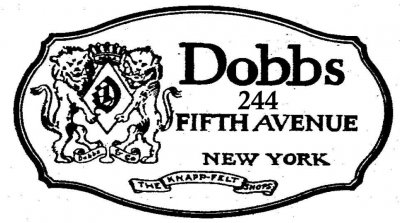 Dobbs244Mockup.jpg93.3 KB · Views: 155
Dobbs244Mockup.jpg93.3 KB · Views: 155 -
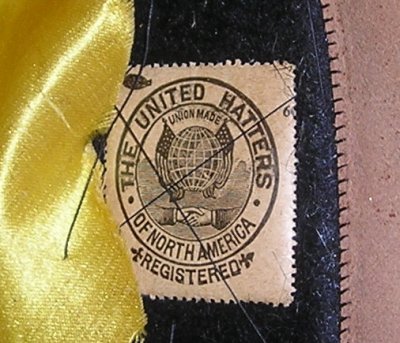 CKUHNALabel.jpg84.2 KB · Views: 135
CKUHNALabel.jpg84.2 KB · Views: 135 -
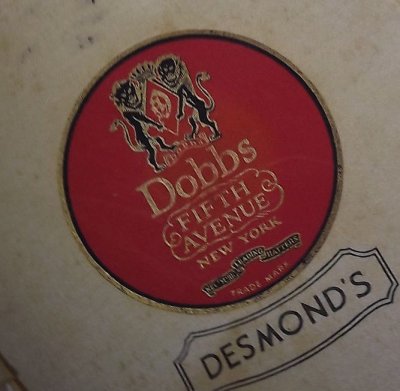 1930sRedRoundel.jpg67.4 KB · Views: 164
1930sRedRoundel.jpg67.4 KB · Views: 164 -
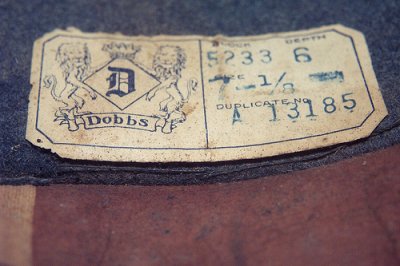 1934-1940Label.jpg138.4 KB · Views: 147
1934-1940Label.jpg138.4 KB · Views: 147 -
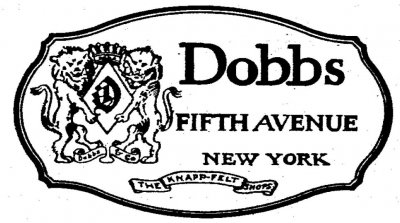 Dobbs.jpg88.9 KB · Views: 137
Dobbs.jpg88.9 KB · Views: 137 -
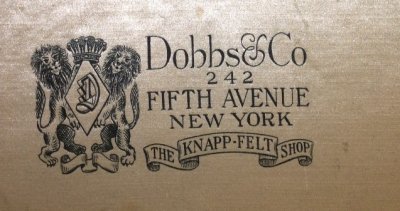 242Tip.jpg110.2 KB · Views: 144
242Tip.jpg110.2 KB · Views: 144 -
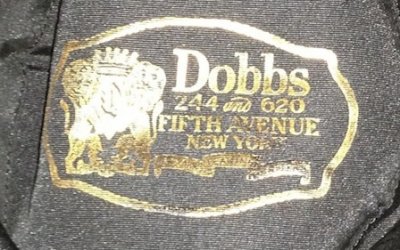 1922TuxedohatTip.jpg72.8 KB · Views: 175
1922TuxedohatTip.jpg72.8 KB · Views: 175 -
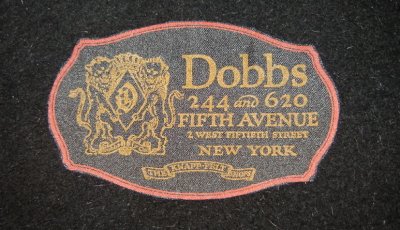 1919-1922Tip Sticker.jpg148.3 KB · Views: 162
1919-1922Tip Sticker.jpg148.3 KB · Views: 162 -
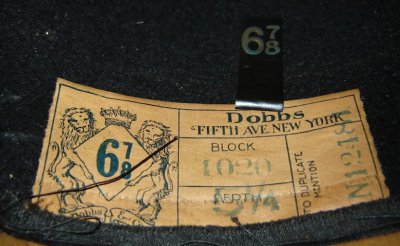 1919-1922Label.jpg104.1 KB · Views: 142
1919-1922Label.jpg104.1 KB · Views: 142 -
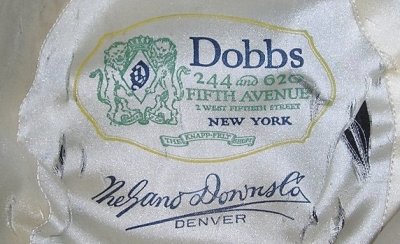 1919-1922DobbsLiner.jpg80.8 KB · Views: 164
1919-1922DobbsLiner.jpg80.8 KB · Views: 164 -
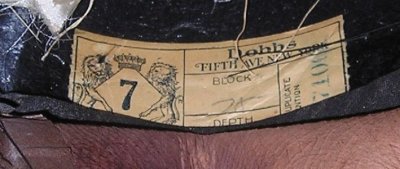 1919-1922DobbsTag.jpg58.9 KB · Views: 171
1919-1922DobbsTag.jpg58.9 KB · Views: 171 -
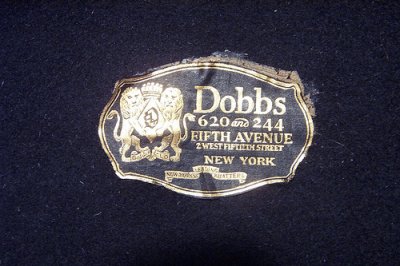 620-244.jpg159.8 KB · Views: 140
620-244.jpg159.8 KB · Views: 140 -
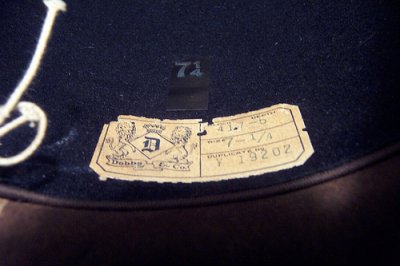 Circa1924factory label.jpg125.1 KB · Views: 166
Circa1924factory label.jpg125.1 KB · Views: 166 -
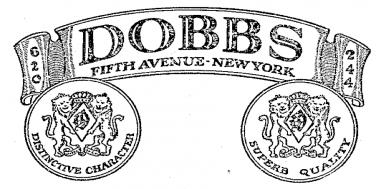 1922Trademark.jpg22.3 KB · Views: 136
1922Trademark.jpg22.3 KB · Views: 136 -
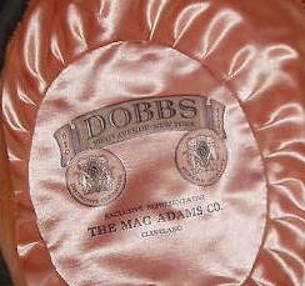 1920sBanner2.jpg21.6 KB · Views: 143
1920sBanner2.jpg21.6 KB · Views: 143 -
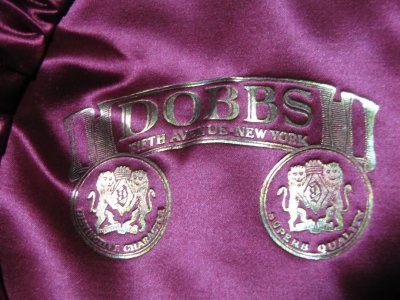 1920sRedTip.jpg160.6 KB · Views: 143
1920sRedTip.jpg160.6 KB · Views: 143 -
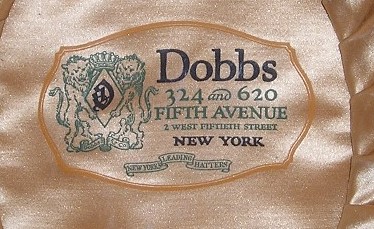 1927LinerTip.jpg45 KB · Views: 140
1927LinerTip.jpg45 KB · Views: 140 -
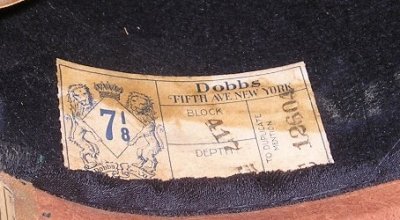 1927Label.jpg54.6 KB · Views: 147
1927Label.jpg54.6 KB · Views: 147 -
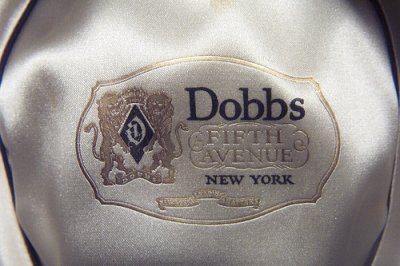 1936Tip.jpg141.7 KB · Views: 137
1936Tip.jpg141.7 KB · Views: 137 -
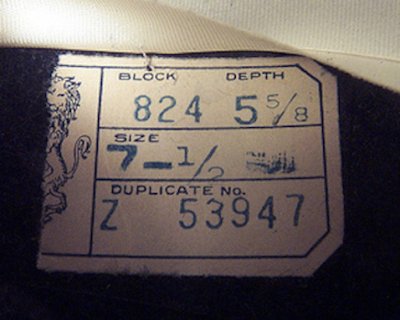 1936Label.jpg114.9 KB · Views: 142
1936Label.jpg114.9 KB · Views: 142 -
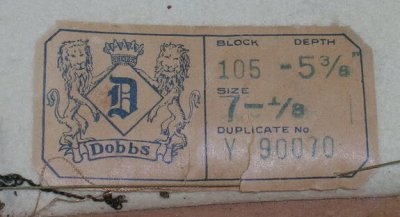 1930sLinelessTag.jpg40.1 KB · Views: 161
1930sLinelessTag.jpg40.1 KB · Views: 161 -
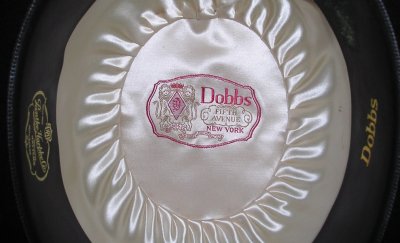 DobbsEmb2.jpg137.7 KB · Views: 148
DobbsEmb2.jpg137.7 KB · Views: 148 -
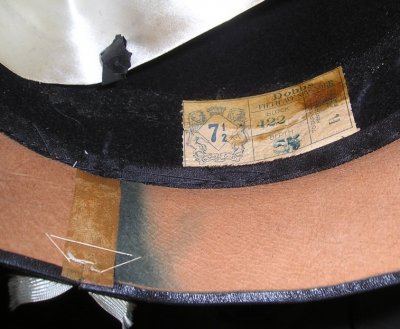 DobbsEmb3.jpg121.3 KB · Views: 136
DobbsEmb3.jpg121.3 KB · Views: 136 -
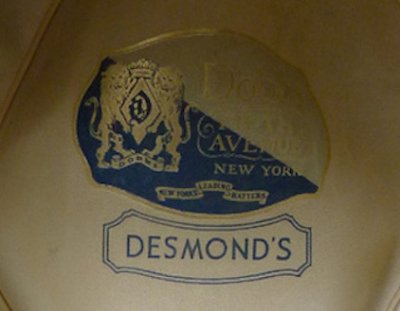 1938HalfBlue.jpg61.8 KB · Views: 145
1938HalfBlue.jpg61.8 KB · Views: 145 -
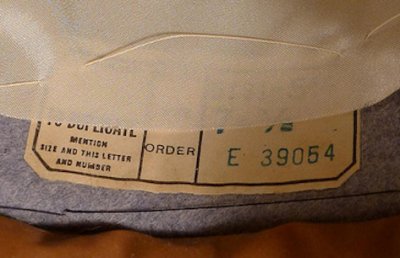 1938LabelVariant.jpg93.7 KB · Views: 155
1938LabelVariant.jpg93.7 KB · Views: 155 -
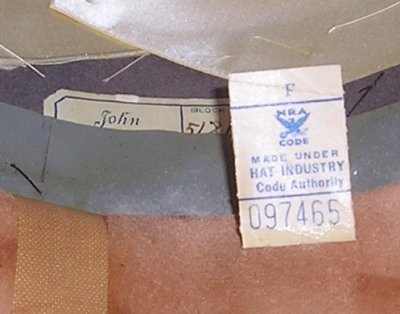 nratag.jpg62.6 KB · Views: 132
nratag.jpg62.6 KB · Views: 132 -
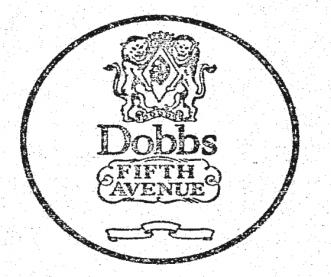 RoundelTrademark.jpg19.6 KB · Views: 177
RoundelTrademark.jpg19.6 KB · Views: 177 -
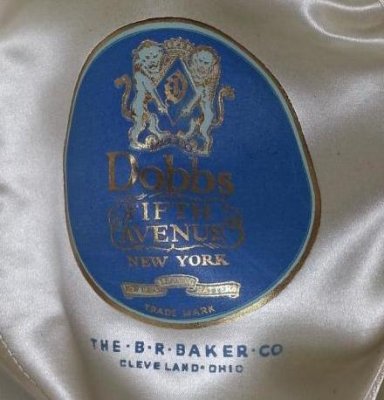 1930sRoundelBlue.jpg35.3 KB · Views: 159
1930sRoundelBlue.jpg35.3 KB · Views: 159 -
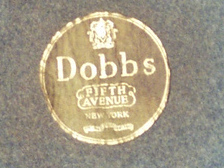 1934-1940Roundel.jpg31 KB · Views: 191
1934-1940Roundel.jpg31 KB · Views: 191 -
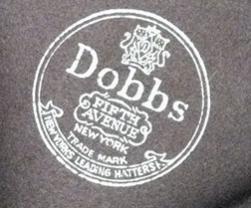 1940Roundel.jpg11.9 KB · Views: 128
1940Roundel.jpg11.9 KB · Views: 128 -
 Another1940TransitionalLabel.jpg43.4 KB · Views: 152
Another1940TransitionalLabel.jpg43.4 KB · Views: 152 -
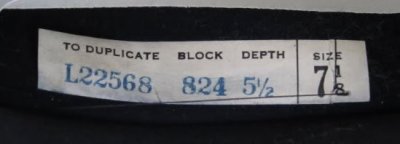 1940TransitionalLabel.jpg20 KB · Views: 157
1940TransitionalLabel.jpg20 KB · Views: 157
